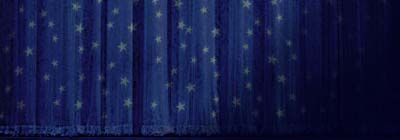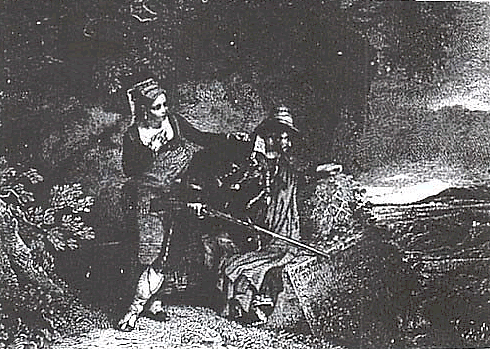
home
"The Brigand Leader and His Wife" from Friendship's Offering, A Literary Album (1827) |
|
Dark chieftain of the heath and height! |

"The Brigand"
Felicia Hemans’ “The Brigand Leader and His Wife” was featured alongside an engraving titled, “The Brigand,” in the 1827 edition of Friendship’s Offering. The engraving had been created first and was sent to Hemans for the creation of the story that would give it a voice. The poem tells the story of a husband who is standing, with rifle in hand, in defense of his home. His wife, who is positioned behind him, is committed to standing in support of her husband despite the danger that she also faces. The husband receives a fatal wound and dies in the presence of his devoted wife who will continue to remain faithful in his absence.
Hemans’ fascination with patriotism and notions of the nation proved to be a perfect match for adding a story line to the engraving that was presented to her. The husband, in the defense stance, posed before his loving wife was defending not only her, but in effect, the nation as well. Tricia Lootens, in her article “Hemans and Home: Victorianism, Feminine ‘Internal Enemies,’ and the Domestication of National Identity,” states that “few poetic careers can have been more thoroughly devoted to the construction of national identity than was that of Felicia Hemans….Hemans’s patriotism attempted to unite [a natural or personal] affection to ‘reason and reflection,’ thus creating a stable, satisfying feminine position that inextricably connected the nation and family” (239). Unfortunately, as Lootens goes on to state, Hemans failed at this attempt. This failure, though it may have been done unconsciously in the composition of this poem, to connect the nation and family is represented in the death of the husband. In his death, the safety and security of his wife and family are unstable and the responsibility has now been shifted to his surviving wife.
This shifting of responsibility is reflected in the change of tone and diction, from harsh to soft, between stanzas three and four. The first three stanzas of the poem focus on the defending, patriotic husband. In the exclamatory first two lines of the poem, the reader’s attention is drawn to the “other” who is occupying the gaze of the couple. This “other,” is defined in terms of the “[d]ark chieftain” and the “[w]ild feaster,” evoking images of savagery. Readers are effeminized in that the speaker instantly places us in a state of fear that may be similar to that of the wife’s. Through diction, Hemans reinforces the harshness attributed to the state of the husband. For example, the sudden strong th, t, s, and d sounds found in “heath,” “night,” “stormy sunsets,” and “dread” give impressions and feelings of masculine nature. The speaker employs the use of the sounds of these words in the first three stanzas to represent the courage and masculinity of the husband that is completely opposite from the wife that stands behind him.
The final three stanzas are much softer in their overall tone and subject focus. Instead of the harsh sounds at the ends of the words, many of the words in these stanzas evoke an airy, almost buoyant, feel. Sounds of words such as “grace,” “all,” and “long” do not stop suddenly as one says them. Instead, these words along with a few others end on a light note, almost fading out from one’s voice. The intentional usage of these types of words corresponds to the shift in focus from the savages to thoughts of religion and the home. Religion and the domestic sphere are responsibilities attributed to women and the shift in focus to these roles reinforced the literary annuals hope to “convince woman that she had the best of both worlds – power and virtue – and that a stable order of society depended upon her maintaining her traditional place in it” (Welter 174).
Domesticity and the emphasis that the Romantic period placed upon a woman’s need to stay in this sphere for fear of corruption is exemplified in the seeming loss of innocence of the woman because she had been “wandering wide/[t]hrough the deep forests” (stanza 4). The societal representative of domesticity, in wandering through the forest and interacting with nature and the public sphere has lost her “meek, religious breast” (stanza 4). Yet in the following stanza, although the woman is mourning the loss of her husband, she still remains devoted and “unchanged” to upholding the sanctity of the domestic sphere.
Through Hemans’ literary interpretation of the engraving, “The Brigand,” the characters that are depicted in a frozen state in time are given a story. The strategic positioning of the woman behind her husband, hand upon his shoulder, is representative of the support and devotion she has for him. The husband is robed in his patriotic uniform representing his social role as defender of his home, both personal and national. It is apparent that these social expectations of men and women were standard during this time period because although it is obvious in the poem, the expectations can be inferred from a simple observation of the engraving itself. Hemans took the expectations represented in the visual art form and placed them in the context of the literary art form.
**Bibliographic entries for citations can be found in the Annotated Bibliography section**
"Evening Prayer, at a Girls' School" : Poem & Engraving
For more insight on literary annuals and this poem along with other works found in the literary annuals, read Dr. Katherine Harris' article "Feminizing the Textual Body: Women and Their Literary Annuals in Nineteenth-Century Britain."